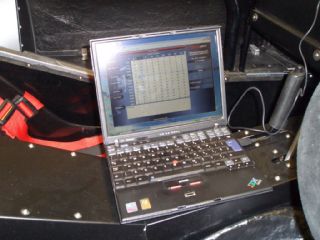By this stage it was getting rather late on Sunday evening, and the
last job left was to try and remap the car using the Power Commander so that it would pass the emissions test.
This of course involved loading the Power Commander software onto the laptop, learning how to use it (naturally,
this did not involve a manual at any point), and then trying to adjust the map. The DASH2 has a Innovate LC1 wide-band
lambda controller to talk to, so I could see from the dash what the AFR was, and it was obvious that it was running
rather rich - an AFR of 12.8:1 at idle.
After a few abortive attempts to pull the map off the Power Commander (the engine needs to be running before a
map can be either up- or downloaded) I got the hang of tweaking the map and spent a whole 15 minutes trying to
get the AFR close to the magic AFR of 14.7:1 at both idle at fast idle (between 2500 and 3000rpm). After 15 minutes
the garage was getting a bit stinky and I was getting a bit bored so I called it a day. Still, the cooling system
seemed to be able to keep the temperatures under control (at idle, at least) with the ECU-controlled fan kicking
in and out nicely, and the DASH2 reading an entirely credible 102 degrees C when it kicked in and 95 degrees C
when it tripped off. |
 |

